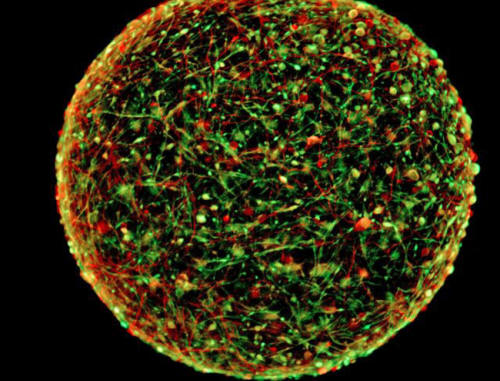|
from ArsTechnica Website
Johns Hopkins
Bloomberg School of Public Health
Tiny ball-shaped noggins may aid research on
Zika, autism, and new drugs.
The mini-brains, which can be personalized based on whose cells they're made from, may soon help scientists study a wide variety of diseases and health problems - from autism and Parkinson's to multiple sclerosis and Alzheimer's, as well as stroke, brain trauma, and infections, such as Zika virus.
In some cases, they may offer a cheaper,
more ethical, and more realistic model for human health than mice
and other animals, he and other researchers said at the conference.
SOCIALisBETTER/Flickr
Some require embryonic stem cells to
make, which are tricky to get and ethically murky to use. And some
of the miniature brains take months to grow and are relatively large
(~5 millimeters), which means that they quickly rot from the inside
out because they lack blood vessels and circulation to feed the
cells imbedded deep in the artificial organ.
The researchers started off with
easy-to-collect adult skin cells and chemically coaxed them to
revert to stem cells, nixing the need for embryonic versions. From
there, the researchers cajoled the cells into differentiating into a
variety of brain cells, including different nerve cells plus
glial cells, which support and
protect nerve cells.
The tiny size allows the brains to slip
past the problem of rotting innards, but they still maintain a
brain-like set up with different types of neurons linking up and
passing signals. The whole process takes just eight weeks and can
produce thousands of mini-brains at once.
Demyelination is a key feature of many neurodegenerative diseases, such as multiple sclerosis (MS).
And the mini-brains spontaneously generated electrical activity, producing brain waves.
There are countless possibilities of how these brains could help research, Hartung said.
In particular, he told Ars that he's most excited to use the mini-brains to study autism and has already made mini-brains from cells from a person with Down Syndrome.
He's also hopeful that the brains will be useful for pharmaceutical companies testing potential new drugs - offering a more realistic model for how drugs work in people without the need to use animals.
After all, Hartung said, humans aren't
150-pound rats.
Still, many researchers at the conference were equally enthused about their potential. After presenting at the meeting, Hartung is now in talks to use the brains to study Zika.
The Zika virus, currently exploding
throughout South and Central America, has been linked to
neurological conditions (some involving demyelination) and a birth
defect called microcephaly, in which babies are born with abnormally
small and malformed brains.
Wilson Compton a drug addiction researcher at the National Institutes of Health hopes the brains could help understand how specific brain regions re-wire in addiction.
Overall, he said, the brains are a
"promising development."
|



